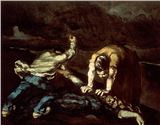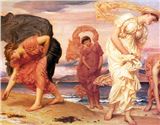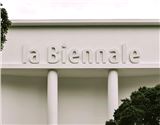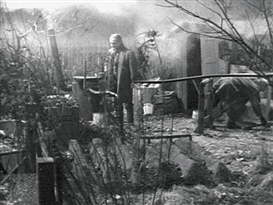Stan Douglas
STAN DOUGLAS DAVID ZWIRNER Stan Douglas`s latest work, the video installation Suspiria, 2002/2003, is as visually weird and conceptually
Nell McClister / ARTFORUM
Jun 01, 2003

DAVID ZWIRNER
Stan Douglas`s latest work, the video installation Suspiria, 2002/2003, is as visually weird and conceptually sophisticated as anything he has ever produced. Titled after Dario Argento`s classic horror film of 1977, the piece was created for Documenta 11 and made its debut there last summer. In Kassel, live surveillance footage of the empty, dungeonlike labyrinth beneath the Herkules monument (one of many follies in the area) was projected in the Fridericianum across town. Scenes from the Grimms` fairy tales, acted out by a contemporary-looking cast in the grotesque, translucent palette of a color television with bad reception, were superimposed at intervals on the black-and-white surveillance video; sporadic voice-over and fragments of music accompanied the actors` dialogue. The scenes themselves appeared in random rotation, and the number of possible permutations ensured that, over Documenta`s one hundred days, the piece would never repeat itself. When Suspiria was presented in New York, the surveillance footage (now taped) and the fairy-tale scenes were also mixed so that, most likely, no two visitors saw the same sequence.
One could say that Douglas`s overall project involves modernism`s promise and the nostalgia that results from its failure. With Suspiria the artist turns explicitly to a few historical moments of Utopian aspiration. Referring to both Das Kapital (in which Marx repeatedly nods to a fairy-tale idiom of drama and transformation) and The Communist Manifesto (which famously opens with the "specter of communism" hanging over Europe), Douglas mines the Grimms` stories for economic and social allegory. The characters here-the inn-keeper, the giant, the poor traveler, the long-suffering servant-act out cryptic vignettes centering on payment and debt while being confronted by alternately nightmarish or ecstatic visions. Each scene inexorably replaces the previous one in a roundelay that itself brings up ideas of exchange and entrapment. Douglas`s ghosts are shadows of a future that never came to pass: the economic and social redemption promised by modernism; the end to alienation foretold by communism. The "ghosts" also point to the obsolescence of a medium, in this case Technicolor (Argento`s Suspiria was one of the last films made in the West using this process).
The layering of the playlets onto the surveillance footage mirrors the impossibility of narrative resolution of various pairs: fairy tale and reality; luck and persistence; have and have not. Since Suspiria is continuously unfolding, no viewer can experience the whole work; in a sense, the "whole work" does not exist. This is familiar ground for Douglas, who involves the spectator as an agent of contingency: His viewer is a singular subject, and each of his works is always many works. His critique of the moving image keeps his projects topical, but in Suspiria there is another layer of urgency. One segment of the voice-over turns out to be Marx`s mocking version of Adam Smith`s account of precapitalist society, in which a hardworking elite accumulated wealth while the lazy poor squandered what they had. In the Documenta catalogue, Douglas suggests that late capitalism`s powerblocs "seem intent on dividing the world into these same two species of being." The Grimms` tales of ghosts in the world, struggling in vain to find shortcuts to happiness and wealth, indeed seem bizarrely contemporary. There is little hope in Douglas`s vision of the present as he invokes the crisis of the self and the lost prospect of social or political change. Yet his ongoing project to unveil the false promises of both history and technology fuels whatever hope there is for the future, which must involve the laying bare of the structures that inform and create it.
COPYRIGHT: Copyright Artforum Inc. Jun 2003. Provided by Proquest- CSA, LLC. All Rights Reserved. Only fair use as provided by the United States copyright law is permitted.
PROQUEST-CSA, LLC- MAKES NO WARRANTY REGARDING THE ACCURACY, COMPLETENESS, OR TIMELINESS OF THE LICENSED MATERIALS OR ANY WARRANTY, EXPRESS OR IMPLIED.







